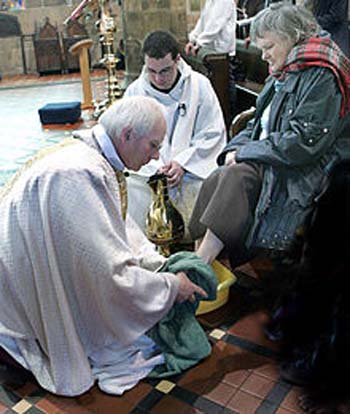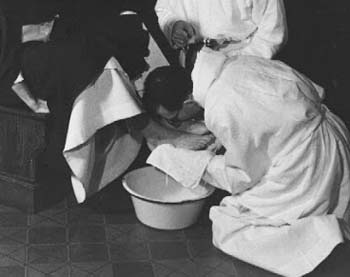Traditionalist Issues
 |
 |
 |
 |
 |
 |
 |
Dialogue Mass - XLVIII
Changing the Meaning of Our Lord’s Mandatum
Most Catholics who have attended a Holy Thursday foot washing service would, if asked, be inclined to explain its significance in a manner not dissimilar to Protestants – that is, as a symbol of the charity and humble service that all Christ’s followers must practice towards one another. That is what the Mandatum has now been reduced to – an exhortation to mutual aid: you wash my feet, I’ll wash yours, metaphorically speaking.
 This impression has no doubt been induced by the sight of a preponderance of laymen upstaging the clergy in the sanctuary to have their feet washed. It came originally from Pius XII’s – or rather Bugnini’s – 1955 Instruction, which gave a secular twist to the Mandatum by presenting it as a charter for general benevolence.
This impression has no doubt been induced by the sight of a preponderance of laymen upstaging the clergy in the sanctuary to have their feet washed. It came originally from Pius XII’s – or rather Bugnini’s – 1955 Instruction, which gave a secular twist to the Mandatum by presenting it as a charter for general benevolence.
That was not, however, how it was perceived throughout the history of the liturgy, particularly by Patristic writers (1) and medieval theologians, none of whom taught that Christ’s action of washing His disciples’ feet was a sign of indiscriminate service to mankind, as is commonly taught today. (2)
It has always been understood that the priesthood of Aaron and the Levites in the Old Testament – all of whom underwent ritual foot washing before service at the altar – was a prefiguring of the Mandatum when Christ prepared His Apostles to become priests of the New Covenant by washing their feet. It was because of this understanding that the Church Fathers gave the Mandatum a mystical interpretation, one that required the Apostles to be cleansed from sin and made like unto Christ.
In other words, the ancient Christian custom of the Mandatum was about the status and identity of the priest as alter Christus. Its exclusive nature as an all-clerical ceremony, as preserved in the traditional Holy Thursday ceremony, was intended to illustrate this identification of Bishops and priests as “other Christs” – which explains why it was distinct from any other kind of foot washing that existed in Church History. (3)
The only explanation, then, that makes liturgical sense is the traditional, hierarchical one: The successors of the Apostles imitate Christ by washing the feet of the clergy who are subject to them: priests, deacons, subdeacons, canons and monks.
A faux symbolism
 That was the situation until 1955 when Pius XII’s Commission altered its complexion and meaning by allowing laymen to replace the clergy. It was a calculated decision of the progressivists, motivated by their antipathy to the hierarchical nature of the Church and it was made with full awareness of the likely consequences.
That was the situation until 1955 when Pius XII’s Commission altered its complexion and meaning by allowing laymen to replace the clergy. It was a calculated decision of the progressivists, motivated by their antipathy to the hierarchical nature of the Church and it was made with full awareness of the likely consequences.
Unsurprisingly, it played into the hands of those who challenged the exalted status of the ministerial priesthood. Cardinal Yves Congar stated:
“We are still far from drawing the consequences of the rediscovery of the fact that the entire Church is one single People of God and that the faithful compose it along with the clergy.
"Implicitly, unwillingly and even unconsciously, we have the idea that the Church is composed of the clergy, and that the faithful are merely their beneficiaries or clientele. This horrible conception is inscribed in so many structures and customs that it appears to be set in stone, unable to change. It is a betrayal of the truth. There is still much to be done to de-clericalize our conception of the Church.” (4)
Pope Francis seconded this with his obliquely accusatory statement that lay people are not “second class members” of the Church. (5)
 Progressivists thrive on this kind of cryptic ambiguity created by the proponents of the “new theology” in order to accuse the Church of having lost the truth and to blur the essential distinction between the clergy and the laity.
Progressivists thrive on this kind of cryptic ambiguity created by the proponents of the “new theology” in order to accuse the Church of having lost the truth and to blur the essential distinction between the clergy and the laity.
We cannot fail to notice that, as a result of this reform, the focus of the Mandatum was suddenly switched to the Protestant “priesthood of the laity,” while that of the ordained minister is constantly being undermined.
Indeed, there is clear evidence of this in Vatican II’s promotion of the laity to official positions traditionally occupied by priests in the Church.
From being a privileged institution on account of its fundamental role in building the Church – the first Apostles were, after all, its nucleus – the priesthood has passed into a kind of limbo, deliberately marginalized as a function of no great consequence, just one of those myriad “jobs” to be performed by the faithful, to which they are allegedly entitled by reason of their common Baptism.
Continued


The Catholic Mandatum now looks like the Anglican foot washing, above, the Bishop of Wales
That was not, however, how it was perceived throughout the history of the liturgy, particularly by Patristic writers (1) and medieval theologians, none of whom taught that Christ’s action of washing His disciples’ feet was a sign of indiscriminate service to mankind, as is commonly taught today. (2)
It has always been understood that the priesthood of Aaron and the Levites in the Old Testament – all of whom underwent ritual foot washing before service at the altar – was a prefiguring of the Mandatum when Christ prepared His Apostles to become priests of the New Covenant by washing their feet. It was because of this understanding that the Church Fathers gave the Mandatum a mystical interpretation, one that required the Apostles to be cleansed from sin and made like unto Christ.
In other words, the ancient Christian custom of the Mandatum was about the status and identity of the priest as alter Christus. Its exclusive nature as an all-clerical ceremony, as preserved in the traditional Holy Thursday ceremony, was intended to illustrate this identification of Bishops and priests as “other Christs” – which explains why it was distinct from any other kind of foot washing that existed in Church History. (3)
The only explanation, then, that makes liturgical sense is the traditional, hierarchical one: The successors of the Apostles imitate Christ by washing the feet of the clergy who are subject to them: priests, deacons, subdeacons, canons and monks.
A faux symbolism

A priest – replacing the sick abbot – washes the feet of other Dominicans in a private ceremony in 1958
Unsurprisingly, it played into the hands of those who challenged the exalted status of the ministerial priesthood. Cardinal Yves Congar stated:
“We are still far from drawing the consequences of the rediscovery of the fact that the entire Church is one single People of God and that the faithful compose it along with the clergy.
"Implicitly, unwillingly and even unconsciously, we have the idea that the Church is composed of the clergy, and that the faithful are merely their beneficiaries or clientele. This horrible conception is inscribed in so many structures and customs that it appears to be set in stone, unable to change. It is a betrayal of the truth. There is still much to be done to de-clericalize our conception of the Church.” (4)
Pope Francis seconded this with his obliquely accusatory statement that lay people are not “second class members” of the Church. (5)

At Francis' invitation, today even women wash the feet of other parishioners
We cannot fail to notice that, as a result of this reform, the focus of the Mandatum was suddenly switched to the Protestant “priesthood of the laity,” while that of the ordained minister is constantly being undermined.
Indeed, there is clear evidence of this in Vatican II’s promotion of the laity to official positions traditionally occupied by priests in the Church.
From being a privileged institution on account of its fundamental role in building the Church – the first Apostles were, after all, its nucleus – the priesthood has passed into a kind of limbo, deliberately marginalized as a function of no great consequence, just one of those myriad “jobs” to be performed by the faithful, to which they are allegedly entitled by reason of their common Baptism.
Continued
- St. Jerome (Epistle to Pope Damasus) stated that the purpose of Christ’s washing of His Disciples’ feet was to prepare them for their duty to preach the Gospel; St. Ambrose (De Sacramentis Book 3, Chapter 1) saw the foot washing as an “aid to sanctification” for the Apostles to resist the assaults of the Devil and concupiscence so as to lead lives of purity befitting their ministry.
St. Augustine (Commentary 56 on the Gospel of John 13:6-10) saw it as a means of purification from contact with earthly things so that hearts may be “turned upwards toward the Lord” and “enabled to dwell in His presence.” This same theme of purification of the soul was used by St. Bernard, St. Cyprian and St. Gregory in their interpretation of the foot washing at the Last Supper. - If humble service, such as the corporal works of mercy or helping the disadvantaged, was what Christ had in mind, the Apostles would have become glorified social workers. But in the Acts of the Apostles we find them specifically rejecting this interpretation in favor of the highest service that Christ had intended for them at the
Mandatum, that of the priesthood:
“Then the twelve, calling together the multitude of the disciples, said: It is not right that we should leave the Word of God and serve tables … But we will devote ourselves continually to prayer and to the ministry of the Word.” (Acts 6:2, 4) - The first Christians undertook this task among themselves as a simple act of charity, recommended by St. Paul (1 Tim. 5:10). Foot washing was also practiced routinely in medieval monasteries both among the monks and as a gesture of hospitality towards guests. On Holy Thursday the Abbot would wash the feet of 12 monks, but this was not part of the liturgy.
- Yves Congar O.P., Mon Journal du Concile, Vol. 1, Eric Mahieu, (ed.), Paris: Cerf, 2000, pp. 135-6.
- From a November 15, 2015, letter to the Pontifical Council of the Laity marking the 50th anniversary of Vatican II’s Decree on the Apostolate of the Laity.

Posted March 29, 2017
______________________
______________________
 Volume I |
 Volume II |
 Volume III |
 Volume IV |
 Volume V |
 Volume VI |
 Volume VII |
 Volume VIII |
 Volume IX |
 Volume X |
 Volume XI |
 Special Edition |


